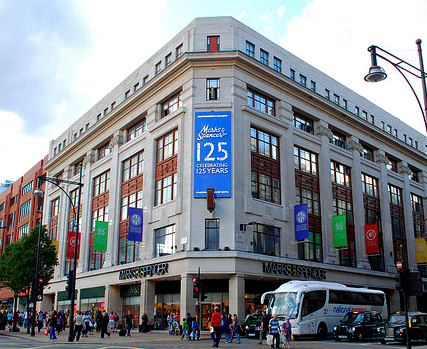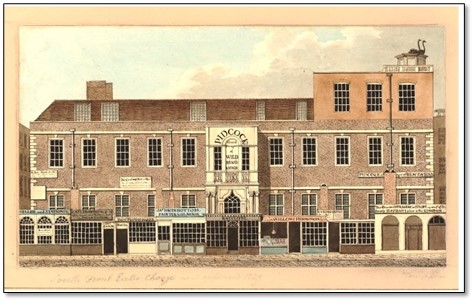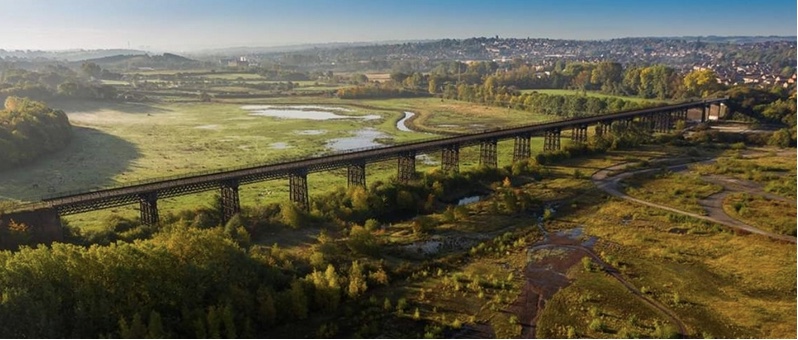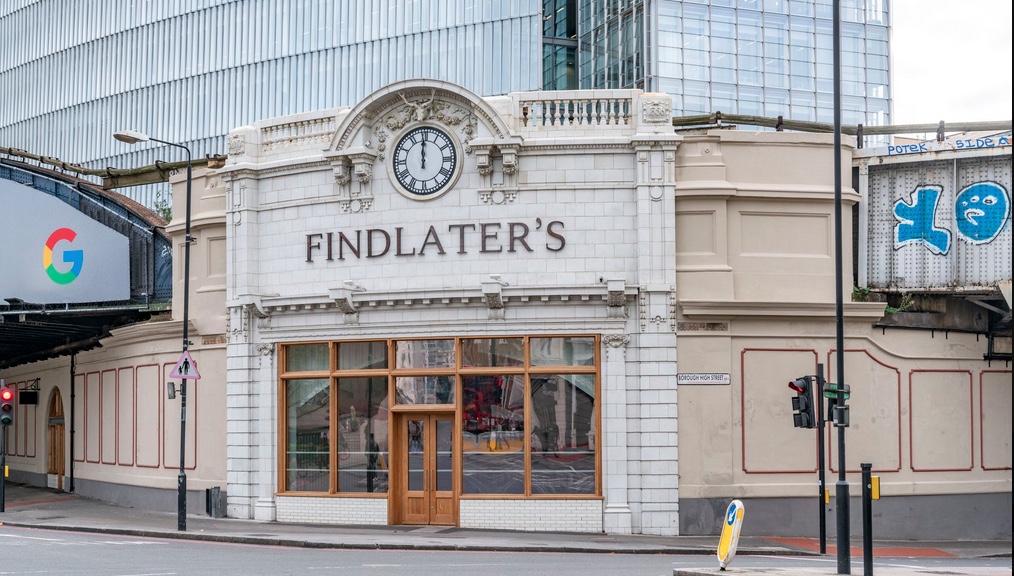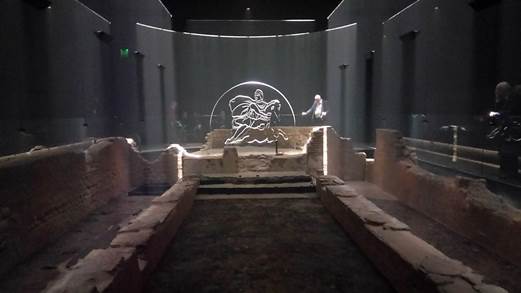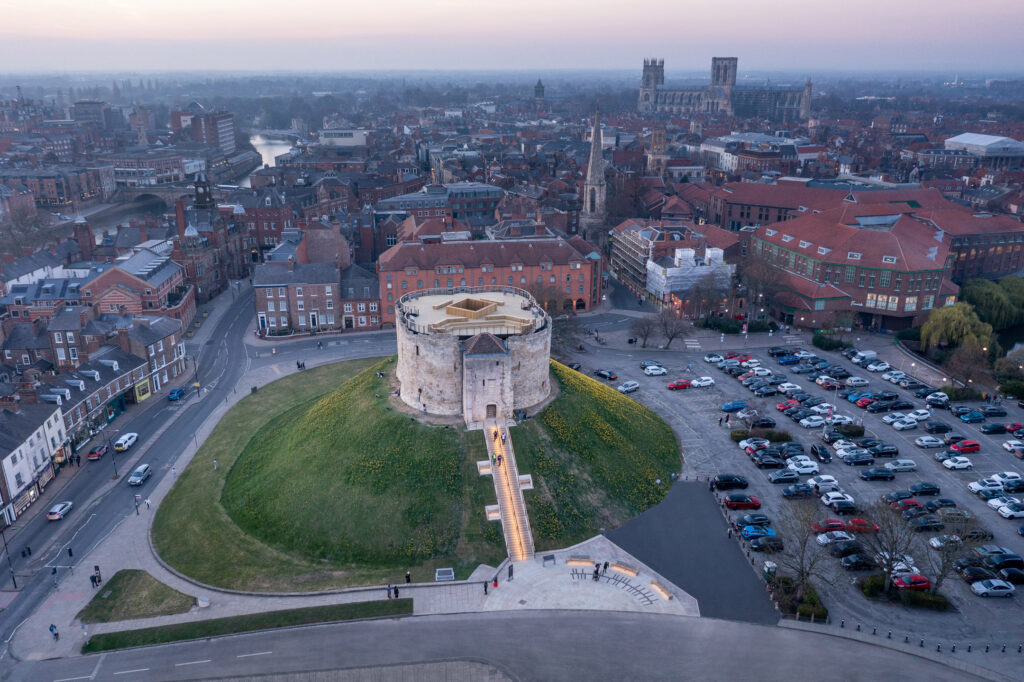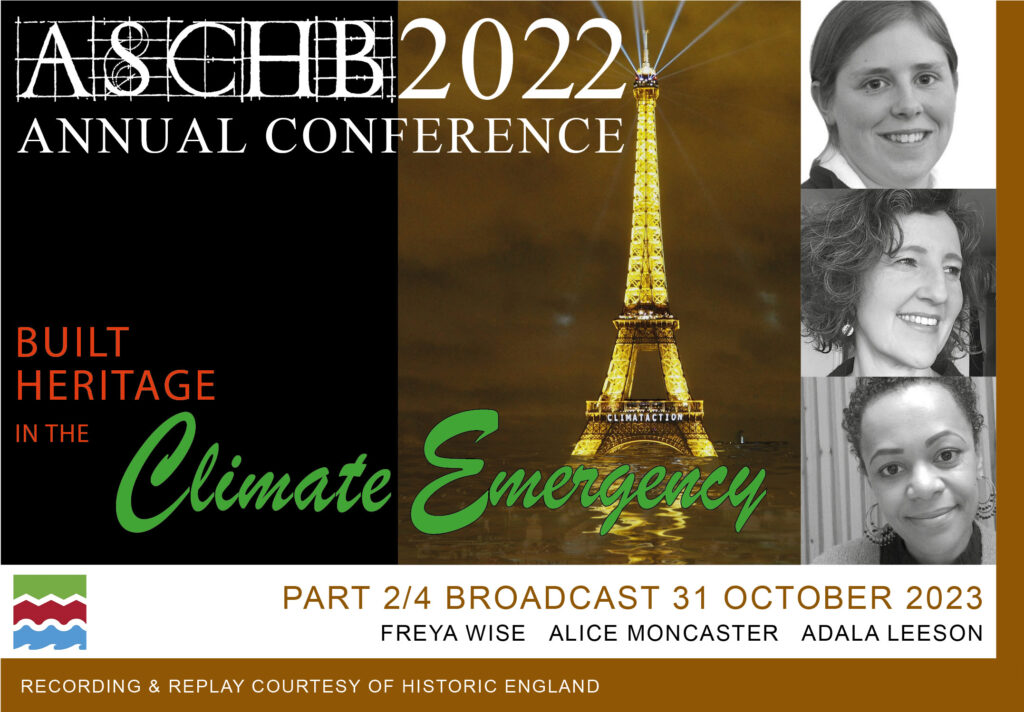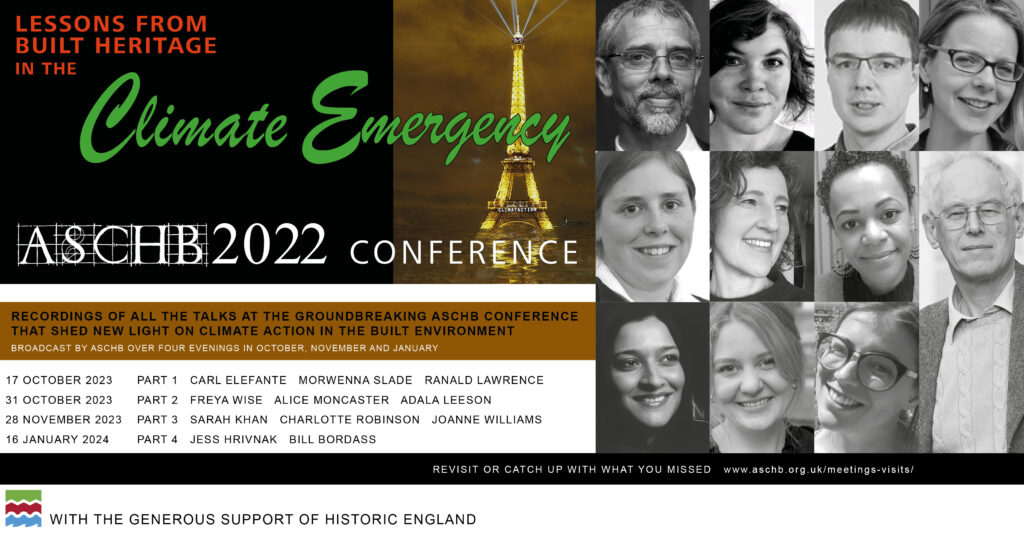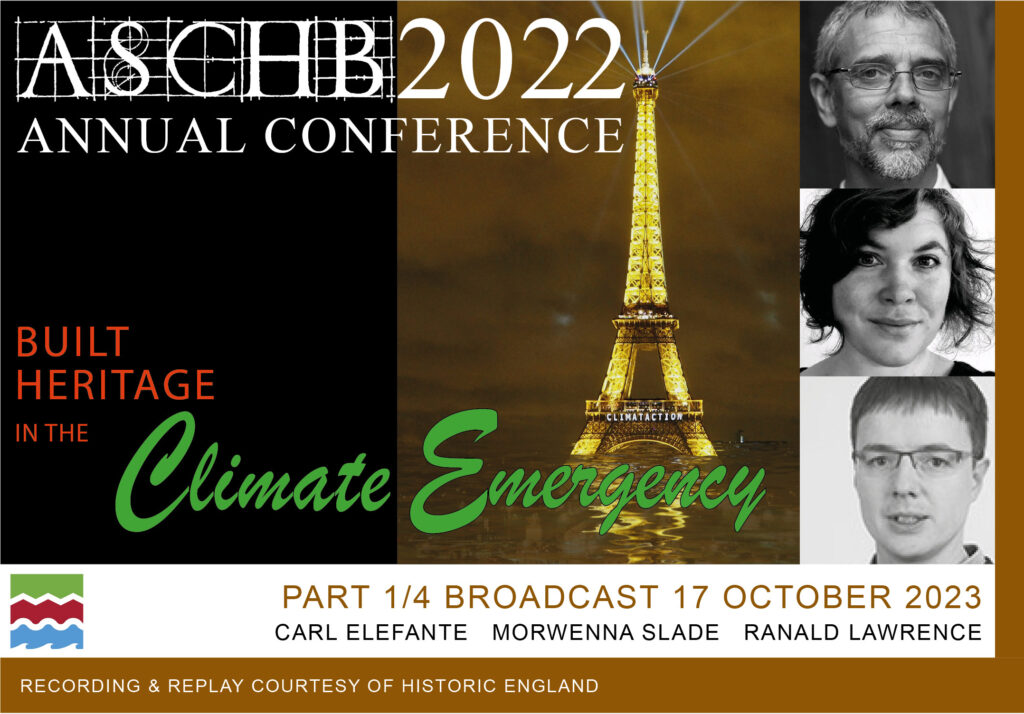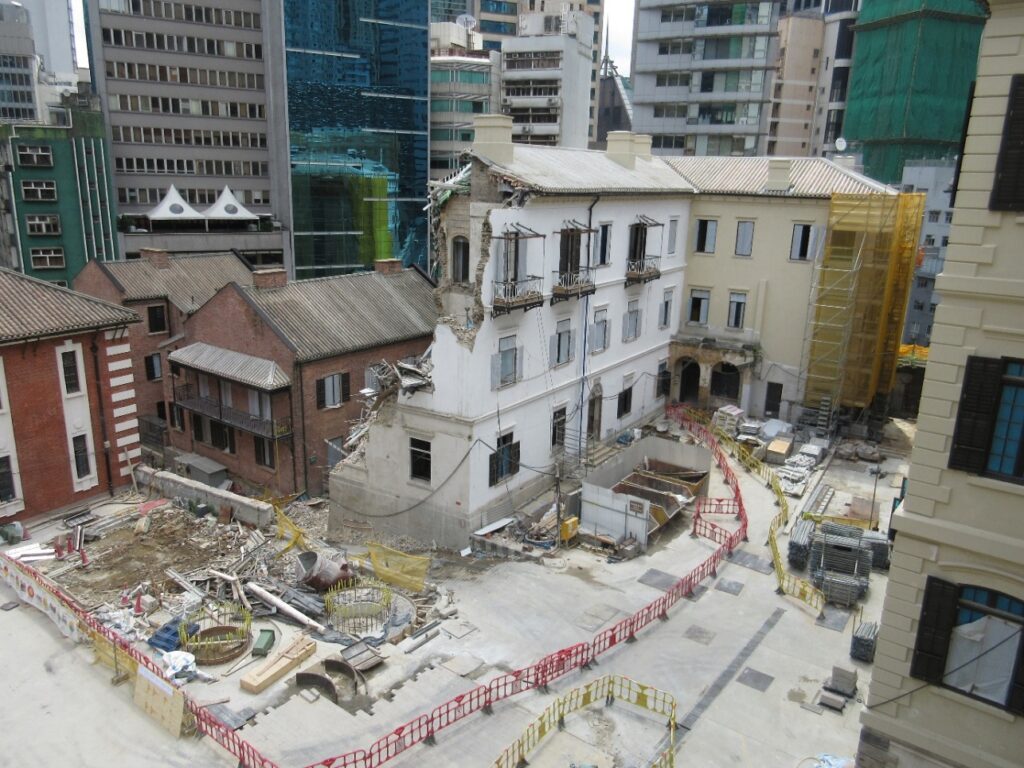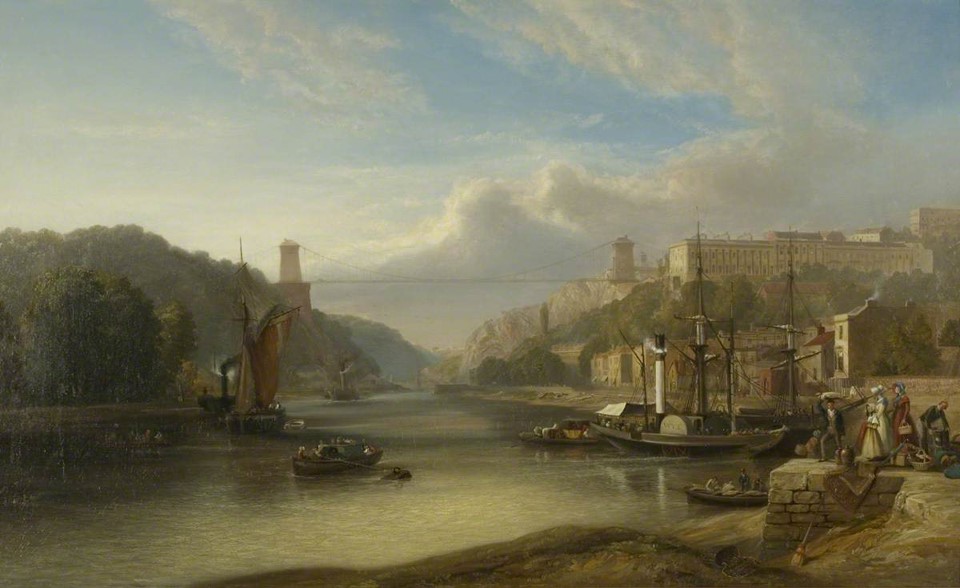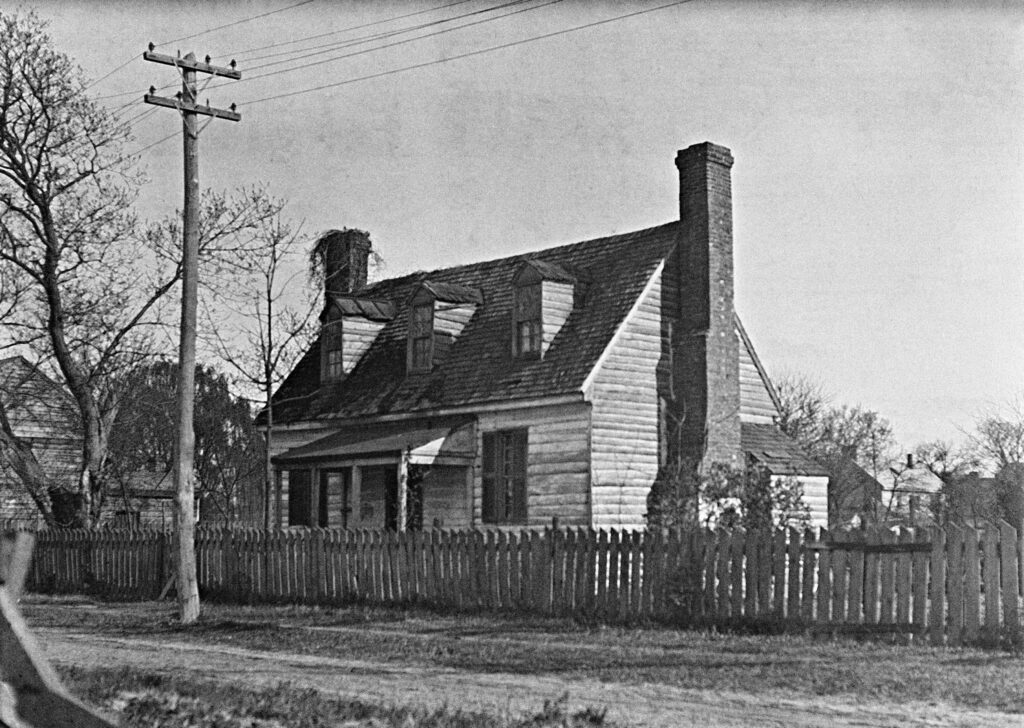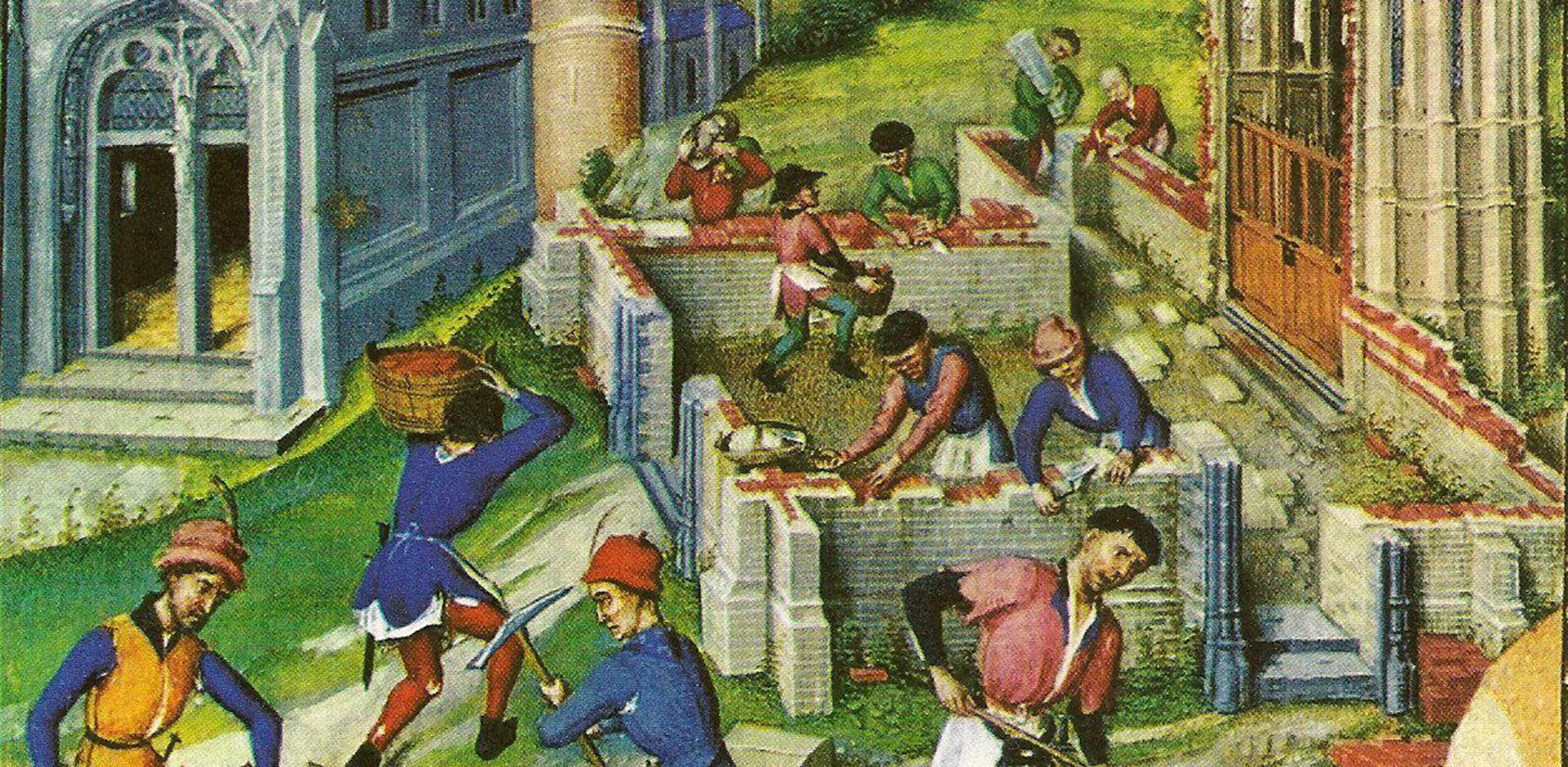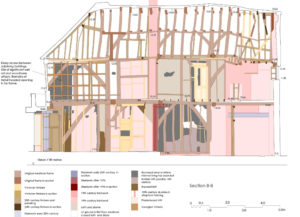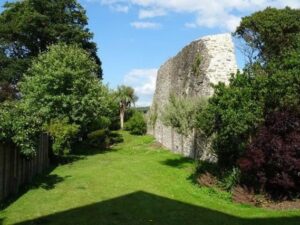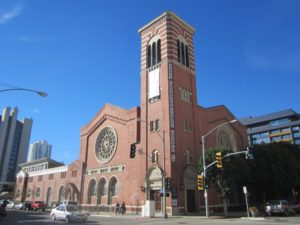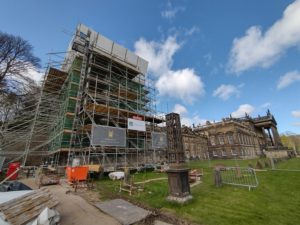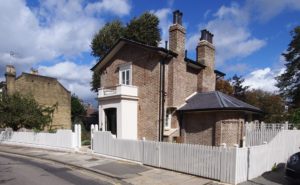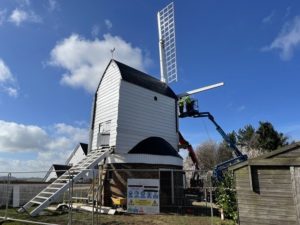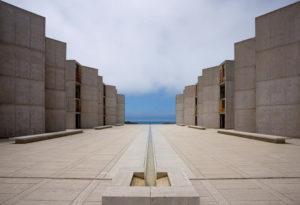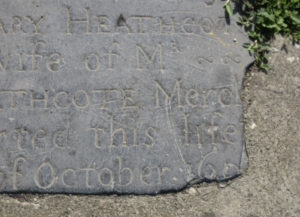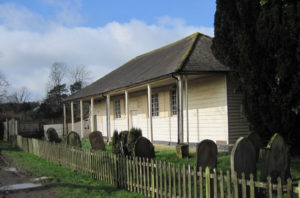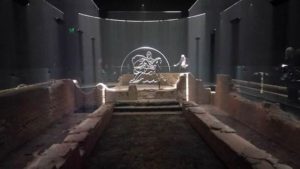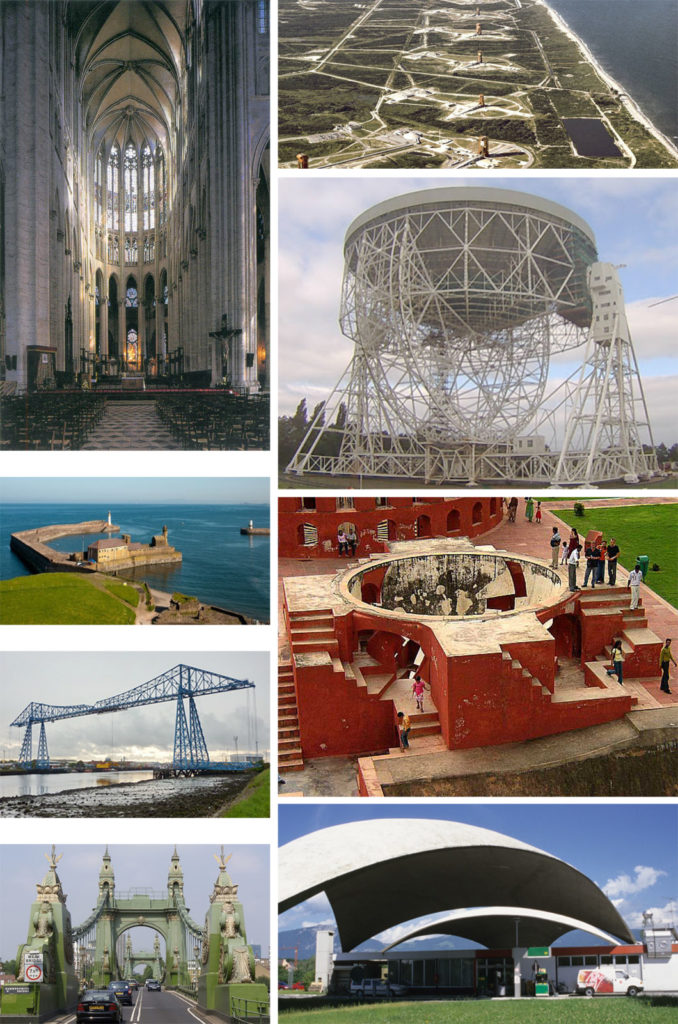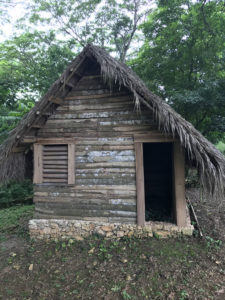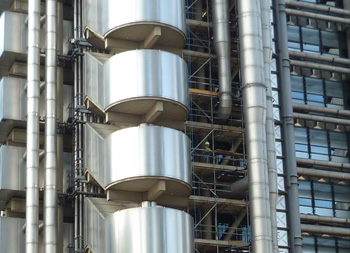

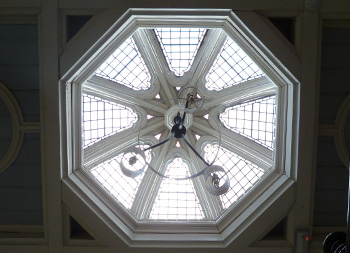

MEETINGS & VISITS
Meetings are held at:
The Gallery, 77 Cowcross Street, London EC1
Nearest tube: Farringdon
Wine is served from 6.00pm – lectures start at 6.30pm
Non-Members are welcome please pay £5.00 on the door.
We also hold meetings on-line through Zoom.
We are delighted to announce that we have been included in the list of IHBC Recognised CPD Providers.
2023 -2024 MEETINGS
RECORDINGS
Links to recordings of the following talks are now available in the Members Area until 5 May 2024 or message us through the CONTACT page.
Andy Savage on Bennerley Viaduct 20 February 2024
Frank Kelsall on Nicholas Barbon: Developing London, 1667-1698 19 March 2024
Kate Clark A Dangerous Thought – has listing had its day? 26 March 2024
26 March 2024 on-line
WHAT: Kate Clark presents a radical new proposition for protecting heritage
WHEN: Tuesday 26 March 2024 18:30
WHERE: Zoom on-line
A dangerous thought – has listing had its day?
In the teeth of a surging climate crisis, the argument for retaining existing buildings has never been stronger. As the construction sector grapples with reducing carbon emissions from buildings, there are increasing imperatives to recognise the embodied energy in existing buildings, and give greater weight to retaining what we have now. At the same time, in some heritage jurisdictions at least, listing is becoming harder and harder as developers push for greater certainty over what is important and for higher thresholds of significance. Has the system of picking winners on the grounds of cultural significance had its day? Are there other ways to give greater weight to retaining the places and things that matter? And should we be focusing on ways to avoid demolition instead?
Kate Clark is an industrial archaeologist, currently based in Australia. She has a long interest in the value of heritage and is currently doing an ICOMOS supported PhD on how best to embed heritage in wider environmental, social and economic policy. Deborah Mays, ex-Head of Listing at Historic England, will be joining us for the discussion afterwards.
Register for the Zoom call through Eventbrite HERE
The event is free for members of ASCHB, non-members are asked to pay £5, Eventbrite also make a small charge for their service.
Past Meetings
Nicholas Barbon: Developing London, 1667-1698
A talk by Frank Kelsall
WHAT: Live talk in London, and Zoom on-line
WHEN: Tuesday 19 March 2024 18:30
WHERE: At The Gallery, Cowcross Street, or live via Zoom
Doors open at 6.00pm at The Gallery
Frank Kelsall will present a talk on Nicholas Barbon and his influence on the development of London after the Great Fire. London grew rapidly in the last quarter of the seventeenth century and Nicholas Barbon was central to its physical transformation. Frank and Timothy Walker have produced the first complete biography which analyses how Barbon’s property development was closely connected to financial innovations. His speculative activity created rows of terrace houses and squares that became the norm for the city’s future development, but at the same time he set up the first fire insurance company, the second bank, became an MP, and published on economic matters such as free trade and recoinage.
Frank Kelsall is an architectural historian who worked on historic buildings in London from 1965 to 1986 with the GLC Historic Buildings Division. In 1986 he moved to English Heritage and became an Inspector of Historic Buildings for the North West including Manchester and Liverpool. He retired from English Heritage in 1998, becoming casework adviser to the Ancient Monuments Society and in 1999 established the Architectural History Practice. He is a past president of the Society of Architectural Historians of Great Britain, and former chairman of the London Society. He is now Chairman of the City of London’s Conservation Area Advisory Committee.
Come and join the presentation and discussion at The Gallery, tickets available at the door, or register for online access via Eventbrite HERE
This event is free for members of ASCHB and for members of ABA
Non-members are asked to pay £5, Eventbrite also make a small charge for this service.
WHEN: Tuesday 20 February 2024 6:30pm
WHERE: At The Gallery, 77 Cowcross Street, or live via Zoom
Doors open at 6.00pm at The Gallery
Bennerley Viaduct
Bennerley Viaduct is an East Midlands landmark, 20 metres high over the River Erewash, and a quarter of a mile long. Grade II* listed, it was built in 1877-78 by the Great Northern Railway, to carry the Friargate Line from Nottingham to Derby, and beyond. It is the longest Victorian wrought iron viaduct in the country, and one of only two still standing.
In 2007, the viaduct was added to the Heritage at Risk Register and it was the only site in the United Kingdom on the 2020 World Monuments Watch, a list published by the World Monuments Fund to highlight heritage sites “in need of urgent action that demonstrate the potential to trigger social change through conservation”.
A condition survey undertaken in 2016, noted corrosion to the ends of the troughs on the bridge deck, damage to brickwork from frost weathering, and missing rivets. In 2017, the Heritage Lottery Fund gave an initial grant to promote engagement and interpretation, which led to the formation of the Friends of Bennerley Viaduct, a community group which works alongside Railway Paths on the restoration and preservation of the viaduct. In 2019 Historic England offered £120,000 to cover a funding shortfall, allowing restoration work to begin the following year.
The work included repairs to the ironwork, the bases of the piers, and abutments and partial reconstruction of the parapets at the eastern end. The embankment at the western end was rebuilt to provide ramped access from the Erewash Canal towpath and steps were built from the eastern end with a wheel trough alongside for bicycles. It opened to walkers and cyclists on 13 January 2022 after the completion of work costing £1.7 million, which was contributed by Railway Paths, the Railway Heritage Trust, and others. In January 2023, funding was awarded towards creating ramped access from the Awsworth end.
Andy Savage was the Executive Director of the Railway Heritage Trust from 2010 to 2022. Following his retirement from that post he has become a non-executive Director and Chair of the RHT.
Prior to joining the RHT, Andy was Deputy Chief Inspector of the Rail Accident Investigation Branch of the Department for Transport, following a long career in railway civil engineering and contractor safety. Andy has a half-century long involvement in railway heritage, with a particular involvement in the Ffestiniog and Welsh Highland Railways.
Andy was awarded an MBE in 2021 New Year’s Honours list for services to the rail industry and heritage.
Andy Savage has talked to ASCHB twice before.
Come and join the presentation and discussion at The Gallery, tickets available at the door, or register for online access via Eventbrite HERE
This event is free for members of ASCHB and for members of ABA.
Non-members are asked to pay £5, Eventbrite also make a small charge for this service.
WHEN: Tuesday 23 January 2024 6.30pm
WHERE: At The Gallery, Cowcross Street, or live via Zoom
Doors open at 6.00pm at The Gallery.
The link to the recording of this talk is now available for 30 days in the Member’s Area, or message us through our CONTACT page.
Findlater’s Corner, The Conservation of a Victorian Winery At London Bridge
The careful conservation of a Victorian-era winery beneath a London Bridge railway arch, known for its stunning baroque revival frontage. Thanks to a £3million project by The Arch Company and Railway Heritage Trust, the building was opened to the public in March 2023. Its four units are used for retail or leisure.
Findlater’s Corner, sits, surmounted by a large clock and ceramic stag’s head, at the southern end of the bridge just west of London Bridge Station. It was established by historic wine merchants Findlater’s Mackie & Todd in 1865, at a time when railways in London were undergoing a huge and rapid expansion. Its original Victorian frontage was replaced in 1900 with a new Beaux-arts facade, made from a glazed terracotta known as ‘Carraraware’. The works included repair of the façade, the Victorian structure behind and the clock above. In doing so a mosaic by Jesse Rust was revealed that marked the entrance of an Express Dairy, to which fresh milk was delivered from the country by railway to be distributed in town…The interior has surprises too.
Architect, historian and former punk musician Benny O’Looney has been a local conservation activist in Peckham where he has lived for 20 years. From ongoing work on Peckham Rye Station and the Jones & Higgins clock tower to Choumert Grove mosque, Khan’s Bargain, few have done as much to ensure that Peckham’s architectural heritage lives on. His expertise particularly with railway architecture has led him to the conservation of Findlater’s Corner which is the subject of tonight’s talk.
Born in 1965 in Fulham to an English teacher father and an art historian mother, Benny moved to Brighton aged six after his mum went to work at the Brighton museum. Then he moved to Wilmington Delaware where his mother took a job in the Philadelphia Museum decorative arts department. After 4 years he moved to New York City and started to pursue a career in music before studying architecture at Yale and Harvard. After graduation in 1992, Benny returned and worked for Grimshaw Architects and then Alsop Architects before starting his own practice which he runs from the ground floor of his home. His practice has a mixture of new build and conservation projects. His is a collaborative approach. He works with many local crafts people, is an active member of the Peckham Society and has strong links with Southwark Council, the Railway Heritage Trust and Network Rail.
Come to join in the presentation and discussion at The Gallery, tickets available at the door
or register for online access via Eventbrite HERE
This event is free to members of ASCHB and for members of ABA
Non-members are asked to pay £5, Eventbrite makes a small charge for this service.
ASCHB 2024 AGM
ASCHB’s fifty third AGM will be held on 16 January 2024 online at 6.30pm
It will be followed by the fourth and final session of the ASCHB 2022 Conference Broadcast
- The trajectory towards an industry standard Jess Hrivnak
- Endnote speech “Where Next?” Bill Bordass
Bill will be joining us afterwards live, to discuss what’s happened with carbon since the conference.
For registration, follow this LINK . You will receive a confirmation email with instructions for joining.
Download the AGENDA
Download the draft MINUTES of the 2023 AGM
Visit to the Mithraeum Tuesday 5 December 2023 5pm
There are still places available for our visit to the Mithraeum with Jane Sidell.
Register HERE and select Meetings and Visits in the ‘I am interested in’ box to book your place.
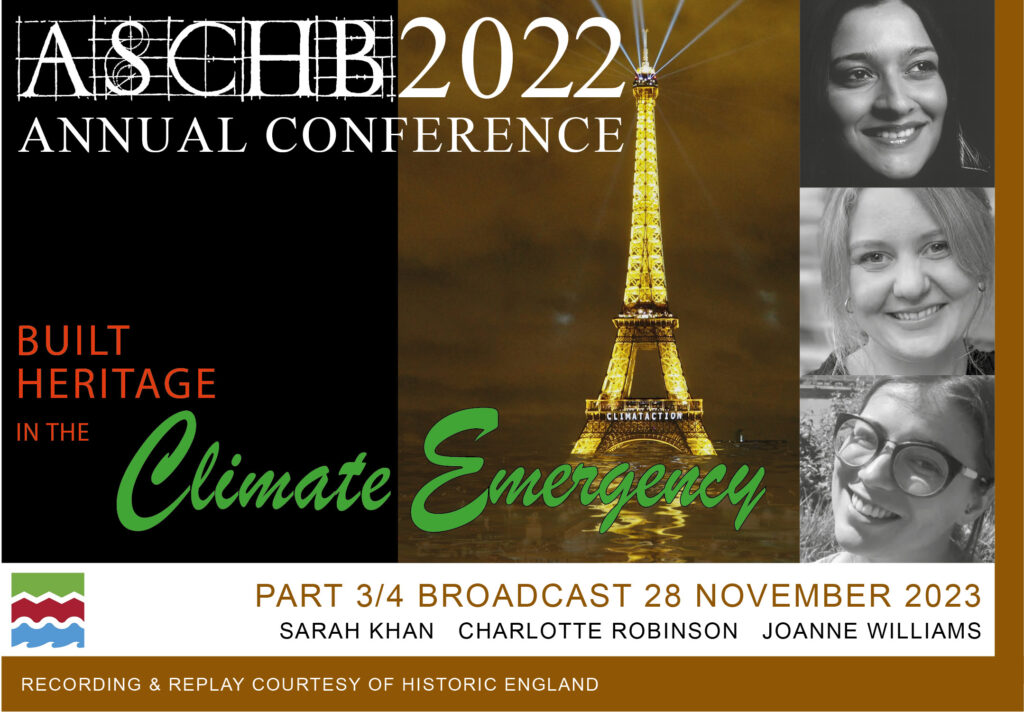 WHEN: Tuesday 28 November 2023 18:30
WHEN: Tuesday 28 November 2023 18:30
WHERE: Zoom Online
The third session of the ASCHB2022 Conference broadcast, including:
- Building Use Sarah Khan
- Planning for the use of Winchester Cathedral Charlotte Robinson
- Flooding and the urban environment Joanne Williams
We hope that Sarah, Charlotte and Joanne will be joining us afterwards live, to discuss what’s happened with carbon since the conference.
Register HERE for Zoom
ASCHB Visit to The Mithraeum, London
WHEN Tuesday 5 December 2023 5.00pm
Following her talk to ASCHB in May 2021, Jane Sidell will lead a visit to The London Mithraeum at the Bloomberg Building, 12 Walbrook, London, EC4N 8AA: Come and join us for a special evening in the run-up to Christmas!
BOOK NOW! There are a limited number of places for ASCHB members and a few for guests: first come first served!
Register HERE and select Meetings and Visits in the ‘I am interested in’ box to book your place
PREVIOUS MEETINGS
WHEN: Monday 13 November 2023 6.30pm
WHERE: At The Gallery, Cowcross Street, or live via Zoom
Doors open at 6.00pm at The Gallery.
Clifford’s Tower, York
Talk on award winning conservation and new works to of one of the most important medieval fortresses in the England by Fay Newham of Ramboll
Clifford’s Tower is a scheduled monument located on a steep man-made motte, dating back to 1068. Now a roofless ruin, it was once the keep of York Castle, one of the most important fortresses in medieval England and the centre of government for the North. In 2014 English Heritage appointed Ramboll for an assessment of the tower and motte for an undefined potential enhancement project. This feasibility stage was key to understanding the structural, geotechnical and archaeological restrictions of the site. The Clifford’s Tower project which emerged was a mixture of traditional conservation and the insertion of a new structure into the roofless ruin. Since reopening in 2022, the project has received acclaim for its simple but stunning architecture, winning a number of national awards, and is currently shortlisted for the international Dezeen Awards.
Fay Newham, chartered engineer and associate for Ramboll, has been involved since the feasibility stage and will talk about the journey to the final solution. Fay has over 35 years’ experience in civil and structural engineering. Since 2000 she has chosen to specialise in projects in the historic environment and has worked on a wide range of survey, conservation and refurbishment projects, including standing ruins, industrial archaeology, barns, castles, bridges and cathedrals.
Come to join in the discussion at The Gallery, tickets available at the door
or register for online access via Eventbrite HERE
This event is free to members of ASCHB and for members of ABA
Non-members are asked to pay £5, Eventbrite makes a small charge for this service.
ASCHB2022 CONFERENCE Online Video
Tuesday 31 October 2023 6:30pm
Where: Zoom Online
The second session of the ASCHB2022 Conference broadcast, including:
- Current use of Old Buildings in Cumbria by Freya Wise
- Assessing Carbon for Long Lifespan Building by Alice Moncaster
- Circular Economy and Long Life Span Buildings by Adala Leeson
Alice and Adala will be joining us afterwards live, to discuss what’s happened with carbon since the conference.
The talk by Ranald Lawrence on Investigating the historic environment at Hardwick Hall will be available online in the second session.
Register HERE
After registering, you will receive a confirmation email containing information about joining the webinar.
Please remember to register with the same email account that you will use to view the event.
OCTOBER MEETINGS
- With the kind support of Historic England, we begin a series of broadcasts (via Zoom) of the highly successful ASCHB2022 Conference (Built Heritage in the Climate Emergency). If you were lucky enough to be there, you can revisit all the talks; or if you weren’t, it’s your chance to catch up with what you missed. Thanks to HE, the broadcasts are free to view: for not only ASCHB members, but for everyone!
- We’re now taking booking for our next site visit, on 5th December in the evening: a tour of The London Mithraeum, under the guidance of the wonderful Jane Sidell of Historic England.
- Our live talk this month (at The Gallery in London or on Zoom) will be Michael Beare, asking the question: are we overdesigning our masonry buildings?
More details on all these events, and how to book for them, below…
ASCHB Conference Online Video
17 October 2023 at 6.30pm.
We will be showing the video of the first session of the ASCHB2022 Conference
Lessons from Built Heritage in the Climate Emergency which took place on April 1 2022.
- Keynote Speech by Carl Elefante
Issues for the Professional by Morwenna Slade
Investigating the historic environment at Hardwick Hall by Ranald Lawrence will be available online shortly.
Register for the Zoom talk HERE
After registering, you will receive a confirmation email containing information about joining the webinar.
Please remember to register with the account that you will use to view the event.
We will be placing a recording on Zoom, accessible for 30 days after this event. The link will be on the Members Area, or use our CONTACT page to request a link.
The climate emergency is with us now. It threatens our very existence; and to meet the challenge we shall have to change how we build and operate our buildings. The historic environment is often labelled the villain in the race towards a more sustainable future, but as conservation professionals know, it is arguably our most valuable resource.
The 2022 ASCHB conference drew lessons from heritage, viewing the historic built environment not as a problem, but as a critical part of the solution. It will look at familiar problems with new eyes:
- The pursuit of ‘net-zero’: what does this really mean, and why is it important? How can our built environment be modified to meet carbon targets, and how do we assess where we are and where we are going?
- Adaptation to overheating, flooding, storms and other weather extremes: can this increase the lifespan and useability of buildings, but simultaneously cut carbon?
- What can the design and use of pre-Industrial buildings and landscapes teach us? Our built environment changed dramatically when we began to burn fossil fuels on an industrial scale. How do we disentangle the many real advances of the industrial age from the myriad changes that have reduced building lifespans, are energy-hungry and belch carbon?
- How have changes in policy, regulation and assessment affected the way we design, construct and use our buildings?
In posing these questions we seek to lay down some foundations for a practical new vision for the future: an interdisciplinary vision that combines the best of both modern and historic technology and practices, avoids maladaptation, and embeds learning and education, so that lessons are learnt and wisdom is passed on.
This is a vision which places the users of the built environment once again at the centre of decisions.
The second session will be shown on Tuesday 31 October, the third on Tuesday 27 November and the fourth after our AGM on Tuesday 16 January 2024.
Are We Overdesigning Our Masonry Buildings?
ASCHB HYBRID MEETING Wednesday 25 October 2023
6.00pm for 6.30pm start in person at The Gallery, Cowcross Street
6.30pm for Zoom event
Michael Beare, noted structural engineer and ASCHB President, will be repeating his talk “Are We Overdesigning Our Masonry Buildings? The Development of Standards and Factors of Safety in Masonry Engineering.” Michael has kindly agreed to repeat his talk from Tuesday 11 April which was beset with technical difficulties.
Come to join in the discussion at The Gallery, tickets available at the door
or register for online access via Eventbrite HERE
This event is free to members of ASCHB and members of ABA
Non-members are asked to pay £5, Eventbrite makes a small charge for this service.
Shrewsbury Flaxmill Maltings: Rescue and Regeneration
ASCHB HYBRID MEETING: Thursday
6.30 pm start for Zoom event and in-person at The Gallery, Cowcross Street (doors open at 6pm for refreshments)
Nick Hill
National Conservation Projects Manager with Historic England
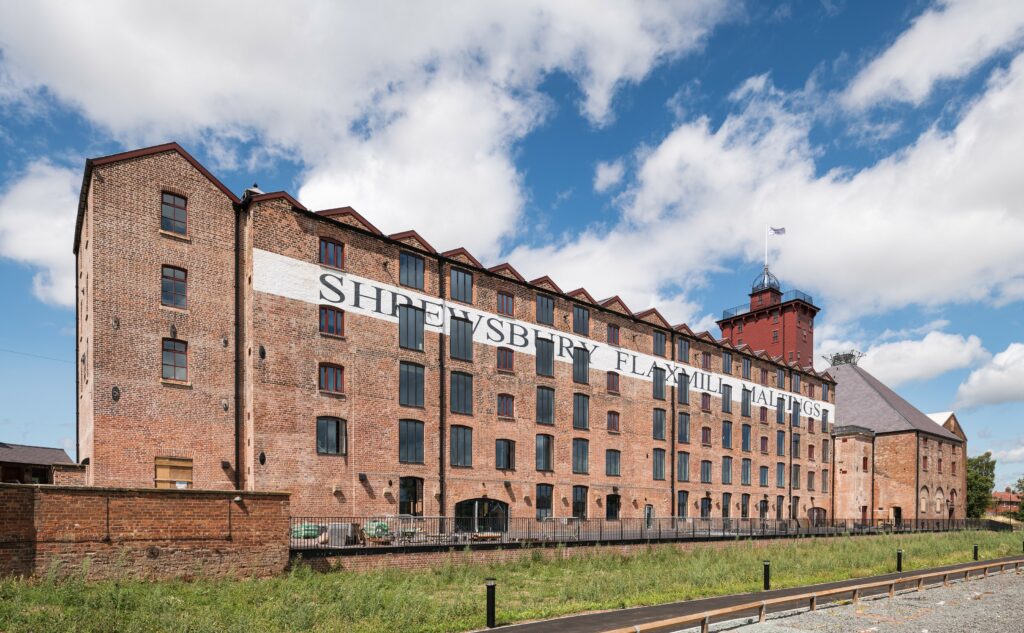
Shrewsbury Flaxmill Maltings. Shrewsbury Flaxmill Maltings, Spring Gardens, Ditherington, Shrewsbury, Shropshire. Main Spinning Mill, general view from the south.
Built in 1797, the Main Mill at Shrewsbury Flaxmill Maltings is famous as the first iron-framed building in the world. After nearly a century as a flax mill, the buildings were converted to a maltings, which closed in 1987. When all other initiatives failed, English Heritage (now Historic England) stepped in to save the site in 2005. After five years of work on site, the £28m Lottery-funded project to transform the Main Mill and Kiln for a third age of re-use has just been completed. Severe structural engineering challenges facing the iron frame had to be overcome, combined with major new design interventions led by architects Feilden Clegg Bradley.
Nick Hill, National Conservation Projects Manager with Historic England, has been project manager for the construction works. Nick is a chartered building surveyor and has worked for English Heritage and Historic England on many projects over three decades, including the rescue of Apethorpe Hall in Northamptonshire. He was co-editor from 1988 to 2006 of Transactions, ASCHB’s annual journal.
Tickets for The Gallery meeting will be available at the door.
Tickets for the Zoom Event are available from Eventbrite HERE and can also be used for the Gallery meeting
There is no charge for ASCHB Members, tickets for non-members are £5 plus Eventbrite’s small charge for the service.
We hope to record this event and make it available through the ASCHB Member’s Area. Please contact us through the website CONTACT page for the log-on to this area.
A Bittersweet Heritage: Slavery, Architecture and the British Landscape.
ASCHB HYBRID MEETING: Tuesday 13 May 2023
6.00 pm for 6.30 pm start for in-person at The Gallery, Cowcross Street
6.30pm for Zoom Event
Dr Victoria Perry
Historian, architect and Practice Director at Donald Insall Associates
Drawn from her recent book A Bittersweet Heritage Dr Perry shows how the profits from plantation slavery not only funded great country houses and gardens, but also transformed some of Britain’s best loved and most celebrated landscapes – the Wye Valley, the Lakes, Snowdonia and the Scottish Highlands – and the way we relate to them. This aspect of Britain’s colonial past, therefore, has left a much wider cultural legacy than is generally appreciated.
The talk shows how the patronage of an absentee Caribbean plantation owner – a ferry ride over the Severn from the Atlantic port of Bristol and the spa-resort of Bath, eighteenth century Britain’s most fashionable city – popularised the idea of ‘natural scenery’, the manner of viewing mountains, rivers and cliffs as three-dimensional landscape art.
Plantation owners, tobacco and sugar and rum merchants based in Liverpool, Lancaster and western Scotland, too, not only commissioned art and buildings that celebrated rugged western landscapes, but organised the construction of new road networks, as well. And, funded from the profits of slavery and the transatlantic trade, this in turn encouraged the 18th and 19th century fashion for landscape touring and appreciation, transforming hitherto poor and remote areas of Britain into much sought-after tourist destinations.
A Bittersweet Heritage also argues that planter families took the concept of ‘natural scenery’ across the Atlantic, to the Caribbean and American mainland, ultimately influencing the way that that much of the 18th and 19th century English-speaking world was portrayed – and, indeed, designed.
Dr Victoria Perry is a historian, architect and Practice Director at Donald Insall Associates, a company of architects and historic building consultants, whose clients include The Crown Estate and the Royal Botanic Gardens Kew, The Palace of Westminster as well as other prominent national and international institutions.
Her recent book A Bittersweet Heritage: Slavery, Architecture and the British Landscape – see https://www.hurstpublishers.com/book/a-bittersweet-heritage/ – is based on her Bartlett PhD which won the Royal Institute of British Architects (RIBA) award for PhD research in 2010.
An external examiner on the MA in Historic Urban Environments at the Bartlett School of Architecture, Victoria has previously spoken about her research in the USA, the Caribbean and India, and contributed to the Oxford Companion to Black British History (2007) and to the English Heritage book Slavery and the British Country House (2014).
Victoria will make here presentation at Cowcross Street, and will also be linked to Zoom. There are two separate events on Eventbrite:
Tickets for the In-Person Event HERE
and for the Zoom webinar HERE
There is no charge for ASCHB Members, tickets for non-members are £5 plus Eventbrite’s small charge for the service.
We hope to record this event and make it available through the ASCHB Member’s Area. Please contact us through the website CONTACT page for the log-on to this area.
Because of the technical difficulties during the on-line presentation, Michael has kindly agree to re-record this talk, and will repeat it at a later date.
Are We Overdesigning Our Masonry Buildings? The Development of Standards and Factors of Safety in Masonry Engineering.
ASCHB Hybrid Meeting: Tuesday 11 April 2023
6.00pm for 6.30pm start for in person at Cowcross Street
6.30pm for Zoom event
Michael Beare, ASCHB President
Our current ASCHB President, Michael Beare, looks at the development of regulations and statutory regulation of masonry in Buildings. He takes as an example the partial collapse of the Married Inspectors’ Quarters of the Old Central Police Station in Hong Kong during restoration in 2016. On 29 May 2016 at about 10.05pm, the northwestern corner of the Married Inspectors’ Quarters Building (MIQ Building) of the Central Police Station collapsed. Built in the early 1860s, it had been declared as a historic monument in 1995. The initial conclusions by the authorities of the causes of the collapse were later overturned in court.
He compares the variance in the strength of binders and factors of safety built into the current Codes of Practice and asks if we are overdesigning our masonry buildings.
Michael has been a Committee member of the Building Limes Forum for 18 years and has chaired the technical committee for some of that time. He was also involved in BSEN 459 on the specification of limes. He was a member of the monitoring committee for The BRE research project into the Field and Laboratory Assessment of lime-Based Mortars, now published in the Journal of Architectural conservation No1 March 2001, and for Christiano Diogo Figueredo’s PhD project on “The properties and performance of lime mortars for conservation: the role of binder chemistry and curing regime” at Bath University in 2018. He has worked on many historic buildings including HM The Tower of London; Coventry and Chelmsford Cathedrals, and Christchurch Abbey; Rye Castle, and Balnagown Castle in Scotland; and Sir Aston Webb’s grade 2* Christ’s Hospital School in Horsham. He is now the Chairman of the Fabric committee of the grade 1 St Mary’s church in Hitchin (was previously a Minster) along with numerous other listed churches.
Michael will make his presentation at Cowcross Street, and will also be linked to Zoom. There are two separate events on Eventbrite:
Tickets are available through Eventbrite for the InPerson event HERE
and for the Zoom webinar HERE
There is no charge for ASCHB members, tickets for non-members are £5 plus Eventbrite’s small charge for the service.
We hope to record this event and make it available through the ASCHB Member’s Area. Please contact us through the website CONTACT page for the log-on to this area.
Hidden in Plain Sight
ASCHB Zoom Webinar 22 March 2023 at 6:00pm GMT
PLEASE NOTE THAT THIS IS ON WEDNESDAY at 6:00pm
Matthew Webster
Executive Director, Grainger Department of Architectural Preservation and Research
The Colonial Williamsburg Foundation
We are thrilled to have Matthew Webster from the Colonial Williamsburg Foundation speak to us about the Bray School, the oldest school dedicated to Black education in the United States. Matthew will unlock the discovery, research and history of this significant site, including its relocation and future at Colonial Williamsburg.
The Bray School was founded in 1760 by the England based group, The Associates of Dr. Bray, to educate both enslaved and free Black children in Williamsburg, Virginia, instructing over 300 students from 1760-1774.
Years of research had been unable to conclusively identify the structure as the building that housed the Williamsburg Bray School. The research conducted in partnership with William & Mary, and partly through dendrochronology, finally identified the structure conclusively in 2020. It is currently being relocated close by, to the Historic Area of Colonial Williamsburg, where its restoration will begin. Future research will highlight how these students used their instruction to make meaning of their lives outside of the ideology shared by the Associates of Dr. Bray.
Matthew’s lecture will showcase the discovery process, ongoing research, and future restoration plans for the Bray School.
Matthew Webster is the Executive Director of the Grainger Department of Architectural Preservation and Research for the Colonial Williamsburg Foundation. In this role he oversees the preservation of 603 structures in the National Landmark Historic Area, the 18,000 piece architectural fragment collection, architectural research, and historic interiors. Prior to Williamsburg he served as Director of Preservation at Drayton Hall (1754) in Charleston, South Carolina. He also served as Director of Restoration for George Washington’s Fredericksburg Foundation in Fredericksburg, Virginia where he oversaw the restoration of Kenmore (1770). Webster sits on the board of Falmouth Heritage Renewal in Falmouth, Jamaica, and on the advisory boards of Preservation Virginia, Stratford Hall and Menokin, in Virginia and Drayton Hall in South Carolina. He has consulted on projects throughout the eastern United States as well as internationally. He has taught at the University of Virginia and University of Mary Washington and lectures frequently on preservation, architecture, and history topics.
Further information on the Bray School can be found HERE
This is one of our joint series of webinars with the Friends of the Georgian Society of Jamaica. See their website HERE for further information.
Tickets are available through Eventbrite HERE . There is no charge for ASCHB or FGJS members, tickets for non-members are £5 plus Eventbrite’s small charge for the service.
This event was recorded and is now available through the ASCHB Member’s Area. Please contact us through the website CONTACT page for the log-on to this area.
2023 Meetings Proposed:
York Minster – Richard Carr Archer
Energy and Buildings: A Perspective from History
ASCHB Zoom Webinar 28 February 2023 at 6:30pm GMT
Dr Robyn Pender
The history of the built environment is enmeshed with the history of energy. How much energy has been locally available, and in what form, has governed all aspects of construction from the evolution of villages and townscapes right down to the fine detailing of buildings and of furnishings. Without appreciating the importance of energy availability, it can be difficult for us to recognise why changes occurred when they did. More critically, it obscures the roots of the many problems we currently face when trying to create sustainable and healthy buildings. Thinking in these terms of the history of construction – particularly of vernacular buildings – opens exciting new pathways to mitigation and adaptation. Dr Robyn Pender takes us on a whistle-stop tour through the historical perspectives first brought together for the Practical Buildings Conservation volumes; and by adding in some basic science along the way, demonstrates why architectural conservation is a key discipline for effectively dealing with the climate emergency.
Dr Robyn Pender recently retired from the Building Climate Adaptation Team at Historic England. Her chief research interest is in the performance of the built environment and the need for specialists to make their communications accessible. She was the author and editor of the of the Building Environment volume of Historic England Practical Conservation Series and editor of the Glass & Glazing, and Metals volumes.
This event was recorded and is now available through the ASCHB Member’s Area. Please contact us through the website CONTACT page for your log-on to this area.
ASCHB ZOOM Presentation of the recording of the talk by Sherry Bates
24 January 2023 6.30pm start
54a High Street Barnet: Discovering an Early Timber-framed Building
Sherry Bates, Bates Zambelli Chartered Architects
The discovery of a rare, medieval, vernacular, timber-framed commercial building in a town centre within Greater London and proposals for its sustainable conservation. This talk will relate the chronology of that discovery at a building previously listed but mistakenly misdescribed, its subsequent reassessment and how that impacted upon the conservation proposals.
Sherry Bates MA BSc Hons Dip Arch IMaPS RIBA AABC is a director of Bates Zambelli Chartered Architects. He is the chair of ASCHB, a past president of the Ecclesiastical Architects and Surveyors Association and sits on Southwark Diocesan Advisory Committee. He has taught in the USA and at most London schools of architecture.
We will be showing the recording of the talk given originally in March 2022
This event is free to members, non-members are asked to pay £5 at the door or through Eventbrite HERE who make a small charge for the service.
ASCHB AGM 2023
Our AGM will be held on-line on January 10 2023 from 6.30pm (GMT) to 8.00pm. The Agenda and Minutes of the previous AGM can be found on the Members Area page. If you have not already done so, please use our CONTACT page to request log-on details to the Members Area.
December Meeting
Our December meeting at The Gallery, Cowcross Street, on 13 December 2022, has been cancelled due to the transport strikes. We hope to re-arrange with Nick Hill his talk on the internationally important Shrewsbury Flaxmill Maltings later in the coming year.
We hope to arrange an online talk for the 13 December, subject to be confirmed.
ASCHB Meeting In-person and on Zoom 8 November 2022 at 6.00pm (GMT) for 6.30pm.
This was our first ‘hybrid’ meeting, with people joining us at The Gallery through a Zoom call. We recorded it, but apologise for the low resolution quality and technical glitches. ASCHB Members can access it through the Members Area on this website. Please contact us through our website Contact page for your log-on to this area.
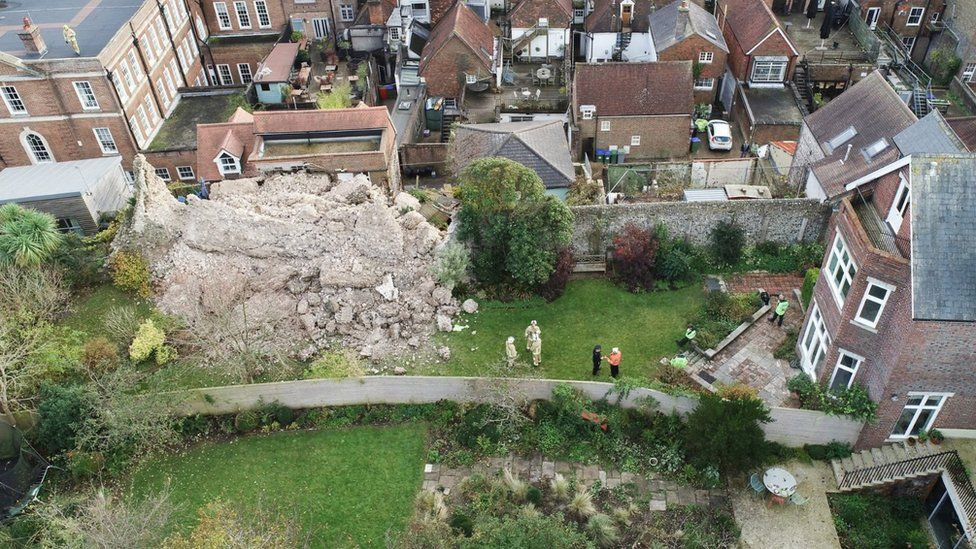 Lewes Castle Curtain Wall after Collapse. Photo by BBC News
Lewes Castle Curtain Wall after Collapse. Photo by BBC News
Lewes Castle Curtain Wall Collapse
Sarah Tattersall, The Morton Partnership and Diccon Hart, HB Archaeology and Conservation Ltd
On the 11 November 2019, a section of the Scheduled curtain wall at Lewes Castle suffered a catastrophic collapse, resulting in extensive property damage and the loss of a significant section of the surviving defences of an early and important castle. The sheer scale of the collapse and the damage it caused has required, from the outset, a truly collaborative and multidisciplinary approach between various organisations and stakeholders, including archaeologists, construction contractors, structural engineers, statutory bodies, and of course the owners of the land affected.
The team included The Morton Partnership with Historic England, HB Archaeology and Conservation, Cheesmur Building Contractors, Potter Raper Construction Consultants, East Sussex County Council, Lewes District Council.
The wall before and after the collapse
Sarah Tattersall will explain the work of stabilisation and clearance of the site, the assessment of the surviving remains and how the team formulated a scheme for reinstatement to meet the needs of the many parties involved. Read further details here
Sarah Tattersall is a conservation accredited engineer at The Morton Partnership with over 16 years of experience as an engineer and specialising in the investigation, repair, and refurbishment of existing buildings, with a particular interest in historic building conservation and the sensitive redevelopment of our historic buildings and structures.
Diccon Hart is a field archaeologist with over 25 years of commercial experience, based in Sussex at HB Archaeology and Conservation Ltd. He has experience in a wide range of projects, from small watching briefs to extensive excavations.
Tickets are available through Eventbrite – click HERE to book. There is no charge for members, and we are not charging for non-members for this event as it is a trial hybrid meeting.
We hope to record this event and make it available through the ASCHB Member’s Area. Please contact us through our website https://www.aschb.org.uk/contact-aschb/ for your log-on to this area.
Previous Meetings
ASCHB Webinar 14 June 2022 at 6.30pm (BST)
Fixing Friable Fabric: brick and terracotta repairs to the 1915 First Congregational Church of Long Beach, California – marine salts, earthquakes and dodgy construction
John Fidler, President and Chief Technical Officer at John Fidler Preservation Technology Inc
Very few terracotta Rose windows ever get structurally repaired, restored or rebuilt – especially in severe earthquake zones. The 1915 First Congregational Church of Long Beach, California (on the US National Register of Historic Places) was built in the Italian renaissance style and has three rose windows and several remarkable stained glass leaded lights. The Church survived a major earthquake in 1933, and had a major seismic retrofit in the mid 1980s. The conservation and restoration of brick and terracotta facades involved some tricky design challenges at the Rose Window where most of the tracery was cracked (corroding armature, of course, but also seismic rupture). And the replacement terracotta came from Darwen Terracotta Ltd., in Blackburn, Lancs.
The project won UK ICON’s Nigel William’s Prize, and American l awards from the Façade Tectonics Institute, the US Victorian Society, the Structural Engineers Association of California, the California Preservation Foundation, and a Long Beach Heritage Award
John spent many years as Conservation Director at English Heritage, where he was responsible for technical policy development, research, advice and standards, publications, training and outreach. Under his leadership, the National Heritage Training Group was established, and the professional accreditation for building conservation developed. He chaired the drafting of British Standard 8221/2: 2000, The Cleaning and Surface Repair of Buildings, and served as Vice President of ICCROM, in Rome. Now an international consultant, based in California, he specialises in non-destructive diagnostics; mortars, plasters and renders; and the conservation of masonry and terracotta. He is currently rewriting Sir Bernard Feilden’s Conservation of Historic Buildings (Routledge, forthcoming) for a fourth edition.
ASCHB members will recall his participation in our 50th Anniversary Conference, speaking on the development of conservation institutions and the growth of conservation research, and his last talk to us in December 2018 on the Academy of Museum of Motion Pictures, Los Angeles, included in Transactions Vol 42.
Tickets are available through Eventbrite – click HERE to book. There is no charge for members, tickets for non-members are £5 plus Eventbrite’s charge for the service.
We hope to record this event and make it available through the ASCHB Member’s Area. Please contact us through our website https://www.aschb.org.uk/contact-aschb/ for your log-on to this area.
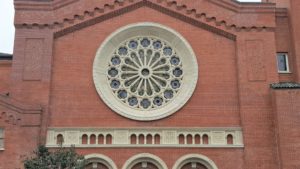
A New Life: Saving the Mansion and the future of the Stables and Camellia House at Wentworth Woodhouse
17 June 2022
ASCHB Members’ Outing at Wentworth Woodhouse 17 June 2022
ASCHB Members at the 2019 Conference, Mills and Booms, will remember the presentations by Henrietta Billings, David Went and John Tanner on Wentworth Woodhouse and Elsecar and the links between the great house and in the mines. The pandemic scotched our plans for a visit to see the huge project of bringing one of the grandest houses in the country back to life. So we are delighted to be able to announce that a visit has been arranged for the 17 June 2022.
Wentworth Woodhouse was in the heart of the Yorkshire coalfield and fell into disrepair when coal was mined within one hundred yards of the house. In 2014 the Wentworth Woodhouse Preservation Trust was established and set to work to repair and develop the house and grounds on a long-term sustainable basis.
Sarah Mcleod CEO Wentworth Woodhouse Preservation Trust, Gez Pegram of Mason Clark Associates Structural Engineer, and Dorian Proudfoot Assoc. Director at Donald Insall Architects will show the vital repairs carried out to the 5 acre roof of the Mansion under the completed Phases 1 and 2 of the Masterplan and share the proposals for the next projects in the masterplan which will restore the Camellia House and provide a new use for the Grade I listed Stables.
We will assemble at Sheffield Rail Station at 11:00am. A coach has been arranged to take us to Wentworth Woodhouse at 11:15am.
Members will meet in the main reception, and Sarah McCleod will give the first talk, followed by a break for lunch. Dorian Proudfoot and Gez Pegram will then present the architectural and structural challenges of the project, followed by a guided tour of the House, Stables, Camellia House and Grounds. Refreshments will be served at the breaks. The coach will then take us back to Sheffield Train Station.
Tickets for the day, including the coach, tours, lunch, and refreshments are £65. As places for this visit are limited to 25 members, bookings are being handled through Eventbrite
Please bring your National Trust membership cards if you have them.
ASCHB Visit:
Wednesday 25 May 2022 at 2.00 pm
Conserving Turner’s Sandycombe Lodge
A guided tour of JMW Turners rural retreat by ASCHB member and project architect Gary Butler BA(Hons) Dip Arch ( Cantab ) PDip RIBA (SCA) AABC
Sandycombe Lodge was not only designed by JMW Turner but was also his rural retreat and place to relax. Turner’s Lodge stood alone in substantial grounds in the early C19 at the edge of two large estates between Twickenham and Richmond Bridge in west London. His town house and studio in Marylebone and Margate have been destroyed and his last residence in what is now Cheyne Walk is in private hands. Sandycombe Lodge in many ways is a remarkable surviving dwelling and one which Gary Butler will be discussing during our guided tour. It follows on from Gary’s excellent article in ASCHB Transactions Volume:43 in 2021 (p.63-67) on the same subject.
Gary Butler BA(Hons) Dip Arch ( Cantab ) PDip RIBA (SCA) AABC is a Director of Butler Hegarty Architects Ltd. He currently teaches building conservation at the Building Crafts College, Stratford London and is an assessor for the RIBA Conservation Register.
There are a limited number of places for the visit, which will be open to ASCHB members and a maximum of two guests each. There will be a charge of £25 for the tour. Tickets are available on Eventbrite who make a charge for their service – Alternatively, reply to this email to book a place, or use the Contact page
ASCHB IN-Person Meeting at The Gallery, Cowcross Street:
Tuesday 10th May 2022 at 6.00pm for a 6.30 pm start
SPAB’S REPAIR PROJECTS: St Andrew’s Chapel, Boxley Abbey Kent and Kibworth Harcourt Windmill, Leics
Matthew Slocombe, Director SPAB & Jonny Garlick, Special Operations SPAB
The SPAB was looking for a project to demonstrate its conservation practice and was offered the chance to buy the Grade II* listed St Andrew’s Chapel, part of the Boxley Abbey site north of Maidstone. It building had been unoccupied since 1973 when the M2 was opened nearby. In purchasing St Andrews in 2018 SPAB embarked on a five-year project to repair this characterful medieval building whilst showcasing the very best conservation methods and materials, to demonstrate conservation practice from burning limestone to make quick lime to making new roof tiles as well as a non-interventionist approach to structural repairs. It was decided to manage the project in house working with Malcolm Fryer Architects, structural engineers and archaeologists. 3D survey of the mill by Terra Measurement allowed the complex structure to be understood. Using in-house project management is has been possible to appoint contractors as needed for different works and to use donated materials and volunteering for some of the work. Going forward an issue is how to reduce the impact of the M2 on the environment in and around the building.
Kibworth Harcourt Mill was gifted to SPAB in 1936.This post mill dating from 1711 is a Scheduled Monument and a Grade II* listed building, it was in need of a major repair programme. To understand the mill a full engineering report by Naomi Hutton, a 3D survey of the mill by Terra Measurement, micro drilling of the main post, a bat survey and an investigation of the graffiti by buildings archaeologist were undertaken. Works commenced in Autumn 2021 to return the mill to full working order with millwrights, Dorothea Restorations appointed. Their major work was to lift up the body of the mill onto a trestle for repairs to be done on the main post.
Link to SPAB Kibworth Harcourt Mill Project
We are intending to record this talk and make it available at a later date.
This event is free to members, non-members are asked to pay £5 at the door or through Eventbrite who make a small charge for the service.
ASCHB Zoom Webinar
Tuesday 26 April 2022 at 6.00 pm BST, (1.00 pm New York)
Copyright Wiss Janney Elstner Associates Inc
Conservation of the Teak Window Assemblies at the Salk Institute for Biological Studies
We were very lucky to have speaker panelists Susan Macdonald, Kyle Normandin, Kenneth Itle, and Deborah Slaton from the U.S. talk to us on the conservation of the teak window assemblies at the Salk Institute for Biological Studies by Louis Kahn. This lecture examines the decision-making processes that led to the selection of appropriate intervention of conservation work at the Salk Institute, focusing on the informed approaches to maintain the teak window wall assemblies and concrete.
In 2013, the Getty Conservation Institute (GCI) conducted initial research and studies at the Salk Institute to develop a conservation program based on understanding the significance of the teak window assemblies including an investigation to assess appropriate levels of intervention. In 2014, the Salk Institute engaged Wiss, Janney, Elstner Associates Inc. (WJE) to build off the investigative studies carried out by the GCI. WJE customized and designed detailed repair approaches to implement a conservation program to retain the original window assemblies, which are critical to the site’s cultural significance.
The panelists will discuss commencement of the conservation program and the technical challenges at the Salk Institute for Biological Studies including selection of appropriate intervention of various types of repair work for one of Louis Kahn’s most recognized works.
Susan Macdonald, Head of Buildings and Sites, Getty Conservation InstituteBsc (Arch) BArch MA (Conservation Studies), RIBA PIA, ICCROM, APTi COF
Susan worked as an architect in London at Purcell, Peter Inskip and Peter Jenkins Architects and in the Architectural Conservation Department of then English Heritage,before returning to Australia where she worked at the NSW Heritage Office. She now oversees a portfolio of international conservation projects and training activities on a range of heritage places,from archeological to modernsites.
Kyle Normandin, Associate Principal, Wiss, Janney, Elstner Associates Inc.(WJE), BA (Arch) MS (Historic Preservation), APTi COF, PAIC
Kyle has held positions with WJE in Los Angeles and San Francisco, the Getty Conservation Institute under Conserving Modern Architecture Initiative (CMAI) in Los Angeles. In 2014, Mr. Normandin was responsible for the investigation and conservation of the teak windows at the Salk Institute for Biological Studies and served as the WJE project manager for a team of experts throughout the repair work which was completed in 2017.
Kenneth Itle, AIA, B.S. (Architectural Studies), M.Arch, is an Associate Principal with Wiss, Janney, Elstner Associates, Inc., in Northbrook, Illinois, specializing in architectural preservation. His experience includes historical research, condition surveys, preparation of repair drawings and specifications, and construction observation for masonry, roofing, plaster, windows, and plaza systems. In 2016–2017, he was part of the WJE team investigating and developing repairs for the teak windows of the Salk Institute for Biological Studies.
Deborah Slaton, FAPT, BA (Art, Architectural History), MA (English, Writing), March (Architectural Structures), is a Principal with Wiss, Janney, Elstner Associates, Inc. (WJE) in Northbrook, Illinois, specializing in historic preservation and materials conservation. She is a Fellow of the Association for Preservation Technology International and a Director of the Historic Preservation Education Foundation. Deborah participated in the WJE projects at the Salk Institute for Biological Studies.
This webinar was recorded and is now available through the ASCHB Members Area for 30 days.
IN-PERSON MEETING at THE GALLERY, COWCROSS STREET TUESDAY 8 MARCH 2022
6.00 pm for a 6.30pm start
54a High Street Barnet: Discovering an Early Timber-framed Building
Sherry Bates, Bates Zambelli Chartered Architects
The discovery of a rare, medieval, vernacular, timber-framed commercial building in a town centre within Greater London and proposals for its sustainable conservation. This talk will relate the chronology of that discovery at a building previously listed but mistakenly misdescribed, its subsequent reassessment and how that impacted upon the conservation proposals.
Sherry Bates MA BSc Hons Dip Arch IMaPS RIBA AABC is a director of Bates Zambelli Chartered Architects. He is the chair of ASCHB, a past president of the Ecclesiastical Architects and Surveyors Association and sits on Southwark Diocesan Advisory Committee. He has taught in the USA and at most London schools of architecture.
We are intending to record this talk and make it available at a later date.
This event is free to members, non-members are asked to pay £5 at the door or through Eventbrite who make a small charge for the service.
ASCHB – VENICE BIENNALE ZOOM WEBINAR – THURSDAY 10 FEBRUARY 2022
6.00 pm – 7.30 pm
For our first webinar of 2022, Alexandra di Valmarana will give you an exclusive, insider tour of one of the most important global architecture exhibitions in the world.
The 2021 Venice Biennale
In ASCHB’s first talk for 2022, Alexandra di Valmarana takes us on a whistle-stop tour of the Giardini Pavilions and Arsenale exhibitions, bringing in her vast local and international knowledge into play to shed some light on common themes of climate, sustainability, resources, adaptive re-use, indigenous materiality, vernacular traditions, and migration.
The 17th Biennale Architettura Venice (Venice International Architecture Exhibition) ran from 22 May to 21 November 2021, under the theme “How will we live together?”, as curated by architect and scholar Hashim Sarkis. One hundred and twelve participants from 46 countries, with strong delegations from Africa, Latin America and Asia and a wide female representation, brought to life the historic Pavilions in the Giardini, the Arsenale and in the historic city centre of Venice.
The Exhibition was organised into five scales (Among Diverse Beings, As New Households, As Emerging Communities, Across Borders, As One Planet), three in the Arsenale, and two in the Central Pavilion.
As Sarkis has commented: “We need a new spatial contract. In the context of widening political divides and growing economic inequalities, we call on architects to imagine spaces in which we can generously live together.”.
Alexandra di Valmarana, has 25 years of international experience in the architecture and heritage sector with Peregrine Bryant Architects, where she was a partner in the practice and remains a consultant. She is a designer and conservator, specialising in sustainable development, heritage consulting, and material science of the built historic environment, with significant on site construction and management experience.
She has worked with UNESCO World Heritage sites, The National Trust, The Crown Estate, Landmark Trust and private clients throughout the US, UK, Italy and the Caribbean. Alexandra is on the ASCHB committee and the Board of Directors for the University of Virginia Architecture School Foundation, The Centre for Palladian Studies in America, The Friends of the Georgian Society of Jamaica, and The Gloria and Marco Foundation (following Grenfell).
No charge to members of ASCHB, non-member’s tickets £5
PLEASE NOTE THAT THIS TALK WILL BE RECORDED AND WILL AVAILABLE TO ASCHB MEMBERS FOR 30 DAYS ON REQUEST THROUGH OUR WEBSITE CONTACT PAGE, or THROUGH OUR MEMBERS’ AREA.
ASCHB – FGSJ ZOOM WEBINAR – TUESDAY 21 OCTOBER 2021
6.00 pm – 7.30 pm
Following the success of our previous webinar with Ke Vaughn Harding on Voices from the Ground – An Enslaved Workers Village in December 2020, we are delighted to present this webinar in association with the Friends of the Georgian Society of Jamaica.
We are very lucky to have Linda Sturtz, Professor of History, Macalester College, St Paul, Minnesota, U.S.A. talk to us this Black History Month and about such an unusual and fascinating subject.
In the eighteenth century, Kingston’s “Spring Path” served as a burial place and location where African Jamaicans gathered to honour their heritage.
When Olaudah Equiano, an African-descended man who wrote a powerful anti-slavery narrative, came ashore in Jamaica in 1771 he was stunned by an event he witnessed at Spring Path:
“I was surprised to see the number of Africans who were assembled together on Sundays; particularly at a large commodious place, called Spring Path. Here each different Nation of Africa meet and dance after the manner of their own country. They still retain most of their native customs: they bury their dead, and put victuals, pipes and tobacco, and other things, in the grave with the corps, in the same manner as in Africa.”
With its complex history, Spring Path possessed symbolic and spiritual power. But this cultural centre was deliberately erased in the nineteenth century and Spring Path no longer exists as a discrete site in modern Kingston.
In this talk, Linda will explore the meaning of Spring Path to late eighteenth-century African Jamaican people before taking listeners on a journey to find its location in present-day Jamaica.
Linda Sturtz’s work at Macalaster College examines the history of early North America and the British Caribbean within an Atlantic world context. She has taught courses on the early modern Atlantic world, music as history and public history.
No charge to members of ASCHB or FGSJ, non-member’s tickets £5
PLEASE NOTE THAT THIS TALK WILL BE RECORDED AND WILL AVAILABLE TO ASCHB MEMBERS FOR 30 DAYS ON REQUEST THROUGH OUR WEBSITE CONTACT PAGE, or THROUGH OUR MEMBERS’ AREA.
ASCHB ZOOM WEBINAR – TUESDAY 1 JUNE
6.00 pm – 7.30 pm
The Providence Chapel at Charlwood
This unique Grade II* building dating from 1798 was on the Buildings at Risk Register. It has been conserved and its fundamental structural problems have been addressed, with the aid of a grant from the Heritage Lottery Fund
The Providence Chapel at Charlwood is a modest building, but described in the Historic England list as “a most unusual building, more typical of New England than Surrey.”
The wooden chapel dates from 1798, but was originally the guardhouse of a barracks in Horsham for troops assembled to repel an expected invasion by a French army under Emperor Napoleon. In 1815 a local farmer, Joseph Flint, moved it to Charlwood on horse-drawn wagons and opened it as a non-conformist chapel.
By 2014 the building was in a parlous state. Its salvation involved complications stemming from Flint’s original deed and reluctance of the Baptist Chapel trustees to accept Lottery money for repairs. In 2013, the chapel was put on the Heritage at Risk Register.
The process of getting grants from the Heritage Lottery Fund took until 2016. The chapel finally re-opened in 2019.
Robert Bowles is an independent conservation accredited consulting structural engineer, dealing with structural issues relating to historic buildings and new construction in the context of historic buildings. He provides specialist conservation advice to other firms of Consulting Engineers, to individual building owners directly, and acts as an expert witness. He is a member of the CARE panel, which oversees the development of the National Register of Conservation Accredited Engineers. In February 2019 his work at the Providence Chapel, Charlwood received the Institution of Structural Engineers South East Region Refurbishment Award.
Amongst his current works are projects at St Paul’s Cathedral, Westminster Hall and the Guard’s Chapel at Wellington Barracks.
No charge to members, non-member’s tickets £5
PLEASE NOTE THAT THIS TALK WILL BE RECORDED AND WILL AVAILABLE TO ASCHB MEMBERS FOR 30 DAYS ON REQUEST THROUGH OUR WEBSITE CONTACT PAGE, or THROUGH OUR MEMBERS’ AREA.
ASCHB ZOOM WEBINAR – TUESDAY 4 MAY
6.00 pm – 7.30 pm
Musing on the Mithraeum
Jane Sidell, Historic England
This talk will look at the current 21st century presentation of the Walbrook Mithraeum, housed within the new Bloomberg building. The talk will explore the history of the peripatetic temple and concepts of authenticity, conservation vs reconstruction and the importance of public enjoyment.
Jane Sidell has been a London archaeologist for some decades, initially at the Museum of London, then English Heritage as science advisor, then was lucky enough to become Inspector of Ancient Monuments. Preservation in situ of archaeological remains is a key area of research interest, coupled with public presentation of archaeology.
No charge to members, non-members’ tickets £5
PLEASE NOTE THAT THIS TALK WILL BE RECORDED AND WILL AVAILABLE TO ASCHB MEMBERS FOR 30 DAYS ON REQUEST THROUGH OUR WEBSITE CONTACT PAGE, or THROUGH OUR MEMBERS’ AREA.
TUESDAY 13 APRIL
6.00pm -7.45pm
Single Use Structures, Then Throw Away: Can all heritage Assets be Repurposed?
An unloved transporter bridge: a dinosaur?
A monastic ruin: Power of Place?
What are we doing and what are economics, culture and environment doing to us?
JOIN US AND DEBATE THE ISSUES!
James Miller will begin our webinar with a short presentation of his thoughts before entering into a discussion with Sherry Bates and Jackie Heath.
This webinar will be recorded and made available to ASCHB members – please CONTACT us for access.
ASCHB: THE FORUM FOR ALL ASPECTS OF THE HISTORIC ENVIRONMENT
THIRD ASCHB ZOOM WEBINAR TUESDAY 2 MARCH 2021
6pm-7.45pm
The recording of this webinar is now available to members, please contact us for the link.
“WHY I HATE STATEMENTS OF SIGNIFICANCE“
Kate Clark
Please book a place on the Webinar through Eventbrite
It is nearly 25 years since I last talked to ASCHB about significance and values. In the late 90s I was working at English Heritage – I had just done the conservation management plan for Whitby and in the run up to Power of Place (2000) we were all grappling with new more inclusive approaches to conservation, putting values and human factors at the heart of decision-making. There was an ongoing battle with the RCHME and the HB Inspectors over whether recording was something you did to inform decision making or after the decision was made, and several of us were trying to get ideas about significance and value into the UK heritage lexicon.
A quarter of a century later, I think they might have won. It seems – from the outside at least – that significance is now something to be defined at the point of designation, or set out in tick box Statements of Significance, based on a list of four values. It is not something that emerges from an inclusive and engaged understanding of place, and then goes on to be part of the negotiation of values between the present and the future – the private and the public. Top down, vs bottom up.
In this talk we will look at how values are only one part of a process of decision-making and why writing statements of significance out of context is not helpful to clients or decision makers. I hope I am wrong, but it feels as if our attempts to create a more inclusive, values-based approach to conservation have been firmly put back in the box.
Kate Clark started out as an industrial archaeologist with Ironbridge Gorge Museums in the late 80s before joining EH as an Inspector of Ancient Monuments in 1993. She later worked with the Heritage Lottery Fund dealing with policy, research and evaluation, as Director of Sydney Living Museums and CEO of Cadw, and in other policy roles. Her latest book ‘Playing with the Past’ contains around 80 activities and games to help people think about the value of heritage.
No charge to members, non-members’ tickets £5
PLEASE NOTE THAT THIS TALK WILL BE RECORDED AND WILL AVAILABLE TO ASCHB MEMBERS FOR 30 DAYS ON REQUEST THROUGH OUR WEBSITE CONTACT page
To buy Kate Clark’s book, Playing with the Past, click here
ISBN 978-1-78920-300-4 Published (October 2019)
ASCHB: THE FORUM FOR ALL ASPECTS OF THE HISTORIC ENVIRONMENT
SECOND ASCHB ZOOM WEBINAR TUESDAY 19 JANUARY 2021
6pm-8pm
Cuba, Conservation and Utopia
Anna Joynt, Allies and Morrison
19 January 2021 6pm start
There is no charge for this event.
This talk is about conservation in a very different context to our own. The international conservation principles may be the same, but the problems and the resources are vastly different. The scale of the Cuban task is staggering but so is the vision, and while the results may raise eyebrows in some conservation circles, there is much to admire. Anna will be talking mostly about the holistic, heritage-based regeneration of Old Havana, a UNESCO World Heritage Site, but also extending the talk to the wider capital and around Cuba. She will touch on the Cuban modern movement along the way, including the seminal Cuban modernist work, the National Schools of Arts. Lastly, she will finish up with a look at the practice of architecture in modern Cuba
Anna Joynt is an architect at Allies and Morrison with a long-standing interest in Cuba. Her 2006 thesis for the Buildings Conservation Course at the Architectural Association was on the heritage-based regeneration of Old Havana. She has since made many return visits to Cuba including two grant-funded research trips; a 6-month study in 2009 funded by British Academy to research hydraulic pressed cement floor tiles, and a report funded by the Zibby Garnett Travel Fellowship on an Old Havana tenement building. Her most recent return to Havana was in February 2020
Please note that this talk will not be recorded
FIRST ASCHB ZOOM WEBINAR 17 December 2020 6pm-8pm
ASCHB was pleased to present this revealing and topical talk as its first webinar
Voices from the Ground: an Enslaved Workers Village in Jamaica
Enslavement, Truth-telling and the Pursuit of Stolen Identities through Architecture and Archaeology at Good Hope Estate, Jamaica
Ke Vaughn Harding, designer and architecture conservator, will speak about the archaeological explorations of the Enslaved Workers Village at Good Hope Estate, one of the largest plantations in Jamaica. His drawings and renderings of the data from an architect’s perspective led to the re-construction of an enslaved workers dwelling house there, which is open to the public. Through his analysis, Ke Vaughn helps us understand the reality of lives of enslaved people and the wider plantation community.
In the summers of 2014 and 2015, archaeological investigations began to provide greater insight into the domestic lives of enslaved workers at the Good Hope Estate in Trelawny, Jamaica. During these studies, Ke Vaughn used reconstructive illustrations of the data and landscape to re-imagine the largely vanished contexts of the archaeological findings. Also expressed in his depictions are hypotheses surrounding the ways of life of the enslaved workers that shaped the physical environment of this location.
Ke Vaughn’s talk explores how reconstructive illustrations served not only as an end product of the archaeological investigations, but also as an active tool in the processes of analysing and interpreting the data collected to reveal truths about enslavement and habitation.
Ke Vaughn has served as the director of Falmouth Heritage Renewal, sat on the national council of the Georgian Society of Jamaica, and acted as Jamaica National Heritage Trust’s representative in Trelawny, Jamaica.
Practical experience and leadership of the rehabilitation of historic dwellings in his hometown of Falmouth, Jamaica, (a World Heritage Site) as well as his academic studies have provided Ke Vaughn with an in depth knowledge of architectural conservation best practices. He is also skilled in interpreting the cultural values represented by the historic built environment.
Following his first degree in Architectural Studies from the University of Technology, Jamaica, he completed a Master of Architecture degree and a Graduate Certificate in Historic Preservation and Regionalism at the University of New Mexico.
There is no charge or fee for this webinar.
CPD – Details of the previous season’s meetings are archived for your CPD records here
Steve Emery talk slides and talk
The results of our November 2017 poll, ASCHB at 50: Influential Books for the most influential books for conservation over the last fifty years are now on the Book Review page

